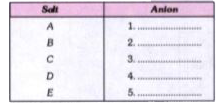A white precipitate is formed when silver nitrate is added to a solution containing chloride ions. This precipitate is soluble in
Hydrochloric acid ;
Nitric acid ;
Dilute
H
2
S
O
4 ;
Ammonium hydroxide ;
Hydrochloric acid
Nitric acid
Dilute H2SO4
Ammonium hydroxide
The correct Answer is:D
To solve the question regarding the solubility of the white precipitate formed when silver nitrate is added to a solution containing chloride ions, we will follow these steps:
Step 1: Identify the Reaction
When silver nitrate (AgNO₃) is added to a solution containing chloride ions (Cl⁻), a white precipitate of silver chloride (AgCl) is formed. The reaction can be represented as follows:
AgNO3(aq)+Cl−(aq)→AgCl(s)+NO−3(aq)
Step 2: Analyze the Precipitate
The precipitate formed, silver chloride (AgCl), is known to be a white solid that is only sparingly soluble in water. We need to determine in which of the given solutions this precipitate is soluble.
Step 3: Evaluate the Options
1. Hydrochloric acid (HCl): Adding HCl would not dissolve AgCl, as it would simply provide more chloride ions, which would continue to form AgCl.
2. Nitric acid (HNO₃): Similar to HCl, nitric acid does not dissolve AgCl because it does not provide a mechanism to break down the precipitate. The ions remain in solution but do not affect the precipitate.
3. Dilute H₂SO₄: Dilute sulfuric acid also does not dissolve AgCl. The solubility product constant (Ksp) for AgCl indicates that it remains insoluble in dilute acids.
4. Ammonium hydroxide (NH₄OH): AgCl is soluble in ammonium hydroxide due to the formation of a complex ion. When AgCl is treated with ammonium hydroxide, it forms a soluble complex ion:
AgCl(s)+2NH4OH(aq)→(Ag(NH3)2)+(aq)+Cl−(aq)+2H2O(l)
Step 4: Conclusion
From the analysis above, we conclude that the white precipitate of silver chloride (AgCl) is soluble in ammonium hydroxide.
Final Answer
Ammonium hydroxide
---
When silver nitrate (AgNO₃) is added to a solution containing chloride ions (Cl⁻), a white precipitate of silver chloride (AgCl) is formed. The reaction can be represented as follows:
The precipitate formed, silver chloride (AgCl), is known to be a white solid that is only sparingly soluble in water. We need to determine in which of the given solutions this precipitate is soluble.
1. Hydrochloric acid (HCl): Adding HCl would not dissolve AgCl, as it would simply provide more chloride ions, which would continue to form AgCl.
2. Nitric acid (HNO₃): Similar to HCl, nitric acid does not dissolve AgCl because it does not provide a mechanism to break down the precipitate. The ions remain in solution but do not affect the precipitate.
From the analysis above, we conclude that the white precipitate of silver chloride (AgCl) is soluble in ammonium hydroxide.
Ammonium hydroxide
Topper's Solved these Questions
- BOOK - ICSECHAPTER - MOLE CONCEPT & STOICHIOMETRY (PART-A GAY LUSSAC'S LAW - AVOGADRO'S LAW-MOLE CONCEPT)EXERCISE - Problems based on Mole Concept & Avogadro.s Number13videos
MOLE CONCEPT & STOICHIOMETRY (PART-A GAY LUSSAC'S LAW - AVOGADRO'S LAW-MOLE CONCEPT)
- BOOK - ICSECHAPTER - MOLE CONCEPT & STOICHIOMETRY (PART-A GAY LUSSAC'S LAW - AVOGADRO'S LAW-MOLE CONCEPT)EXERCISE - Problems based on Mole Concept & Avogadro.s Law2videos
MOLE CONCEPT & STOICHIOMETRY (PART-A GAY LUSSAC'S LAW - AVOGADRO'S LAW-MOLE CONCEPT)
- BOOK - ICSECHAPTER - ACIDS, BASES AND SALTSEXERCISE - Unit Test Paper 3A- Acids, Bases & Salts14videos
ACIDS, BASES AND SALTS
Similar Questions
Knowledge Check
- Question 1 - Select One
The colour of the precipitate formed when ferrous ions react with ammonium hydroxide solution
ABlueBReddish brownCDirty greenDWhite - Question 2 - Select One
A chloride which forms a precipitate that is soluble in excess of ammonium hydroxide is :
ACalcium chlorideBFerrous chlorideCFerric chlorideDCopper chloride
Dilute sulphuric acid will produce a white precipitate when added to a solution of
View SolutionThe colour of precipitate obtained when ammonium hydroxide is added to ferric chloride is ……………………
View SolutionThe precipitate formed by mixing silver nitrate and sodium chloride disappears on adding ethylamine. It is due to the formation of
View SolutionState what is observed when hydrochloric acid is added to silver nitrate solution.
View SolutionA black precipitate is obtained when H2S is passed through a dilute acidic (HCI) aqueous solution containing
View SolutionSalts A, B, C, D and E undergo reactions (i) to (v) respectively. Identify the anion present in these salts on the basis of these reactions. Tabulate your answers in the format given below:
(i) When silver nitrate solution is added to a solution of A, a white precipitate, insoluble in dilute nitric acid, is formed.
(ii) Addition of dilute hydrochloric acid to B produces a gas which turns lead acetate paper black.
(iii) When a freshly prepared solution of ferrous sulphate is added to a solution of C and concentrated sulphuric acid is gently poured from the side of the test-tube, a brown ring is formed.
(iv) When dilute sulphuric acid is added to D a gas is produced which turns acidified potassium dichromate solution from orange to green.
(v) Addition of dilute hydrochloric acid to E produces an effervescence. The gas produced turns lime water milky but does not affect acidified potassium dichromate solution.
 View Solution
View Solution

